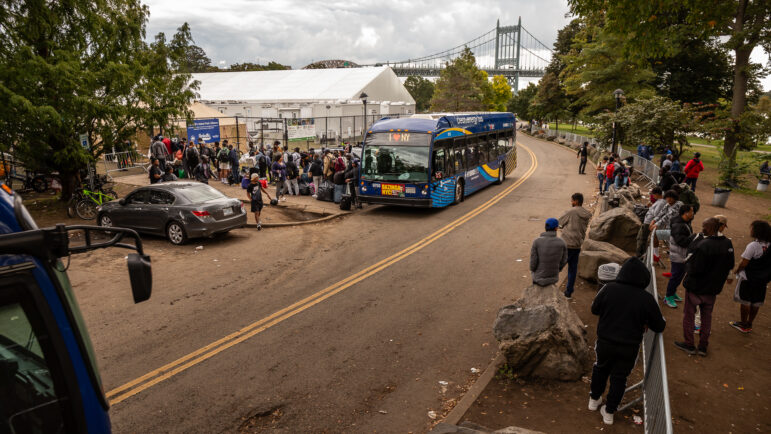“Programs and policies to facilitate intra-state transfers of asylum-seekers would be a win-win, both for small cities that need an injection of people and economic drawing power, and for large cities that have traditionally been a magnet for immigrants and refugees, but are currently overwhelmed by the influx of new arrivals.”

Adi Talwar
New York City’s tenant shelter for new immigrant arrivals on Randall’s Island, pictured herein October 2023.City spending on immigrants and asylum seekers will be a focal point for upcoming deliberations on the city’s fiscal year 2025 budget. According to the city’s Asylum Seeker Funding Tracker, as of February, the city has spent approximately $4.05 billion on efforts to shelter newly arrived immigrants.*
Clearly, the city and state cannot sustain this level of financial support indefinitely. But focusing on dollars risks ignoring the importance of strategic relationships that could be an important part of the solution.
Data consistently shows a positive economic impact in big cities with high concentrations of immigrants and refugees. The impact on small and mid-sized cities—places like Akron in Ohio and Lewiston in Maine—are often overlooked. But what about closer to home?
Using data from the most recent American Community Survey, the Census Bureau projects that, with the exception of the Albany-Schenectady-Troy Capital District, every region of New York State has had a net loss of population since the 2020 Census. If not for the substantial in-migration of people from other places, the state would have had even greater population loss.
With a total population of about 65,000, Utica sits at the foot of the Adirondack Mountains in Mohawk Valley, about 250 miles northwest of New York City. Once a manufacturing hub, it began losing population in the mid-1900s and by the 70s was a city in steep decline, having lost a third of its population and much of its job base.
About that time, a local nonprofit organization, the Mohawk Valley Resource Center for Refugees, became known as a place where other non-governmental organizations could refer refugees from southeast Asia for services and help resettling in upstate New York. The Center’s constituents soon expanded to include people from the former Soviet Union, Bosnia, and other war-ravaged places. Now it helps resettle families from Afghanistan and Ukraine.
Today, one out of every four Utica residents is a resettled refugee, the population is growing, and whole neighborhoods have been revitalized. The city is experiencing the best kind of economic growth: the kind that’s not dependent on a handful of large corporations that can pick up and leave for cheaper wages and sunnier climates. Utica’s job growth is partly driven by a diverse and dense network of small businesses (many of them started by entrepreneurial-minded refugees), along with larger employers who are attracted by the stability of its working age population.
Programs and policies to facilitate intra-state transfers of asylum-seekers would be a win-win, both for small cities that need an injection of people and economic drawing power, and for large cities that have traditionally been a magnet for immigrants and refugees, but are currently overwhelmed by the influx of new arrivals.
The mayor and governor should jointly assign a senior level point person to start conversations with public officials in small cities where population and jobs are shrinking and if interested, work with them to pressure Washington D.C. for money and to smooth bureaucratic snafus like work authorizations. Recruit prominent small city business leaders for their vocal (and financial) support. Work with local chambers of commerce and religious leaders. Those who are reluctant to engage due to fear of anti-immigrant backlash can step aside, and let creative, forward-thinking leaders step in.
The best place to start this relationship-building is with effective and trusted community organizations. One example is in the works: the Arc of Chemung-Schuyler and the Community Foundation of Elmira-Corning and the Finger Lakes are floating a pilot program that would resettle a small number of asylum-seeker families from New York City to Watkins Glen, with appropriate services and support. Groups like the Arc are the on-the-ground partners who will make it work.
Fortunately, recognizing that statewide networks are essential for getting anything done in Albany, a few New York City-based nonprofits have done a good job of connecting with like-minded groups upstate. These groups, like Make the Road, NY Immigration Coalition, VOCAL, and others, can help connect Mayor Eric Adams’ top advisors to groups throughout our vast state.
Transformations like these won’t happen overnight. It will take sustained effort and significant investments in people and infrastructure. But while waiting for Congress to get its act together, we can get started now on these and other important first steps towards long-term solutions.
Patricia Swann is an independent consultant. She anchored grantmaking for the New York Community Trust in the areas of community development, affordable housing, civic affairs, and nonprofit capacity-building for more than 20 years. She is a member of the GoVoteNYC Advisory Committee, former chair of the New York State Census Equity Fund, and former co-chair of the Change Capital Fund.
*This piece was updated to include more recent spending figures from the city.








